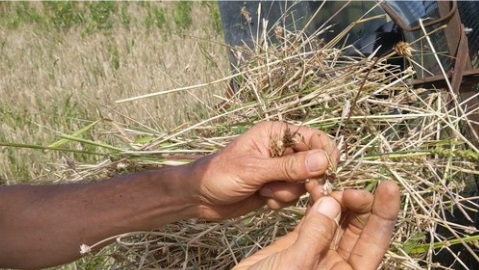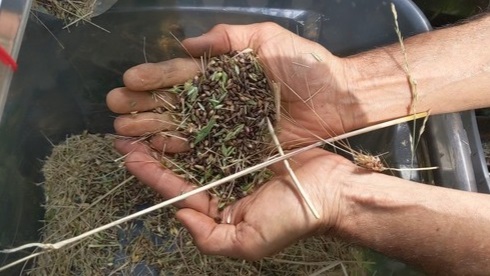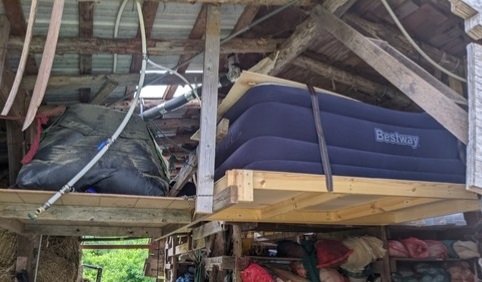Living Energy Farm
May 2024 Newsletter
There have been two big events at Living Energy Farm in the last month. The first is that we are now using our simplified combine harvester in the field to harvest grain, and it’s working. The second is that, after 14 years of cooking on solar and wood, we are now making a lot more biogas and have enough to say goodbye to firewood.
And The Central Virginian newspaper here in Louisa VA did a very good article about LEF. That is here.
Easy Reaper
We have renamed our simplified combine harvester the Easy Reaper. Almost everyone relies on grain for food directly or indirectly. In the U.S., farmers have access to old American equipment. But the smallest combine harvesters are still fairly large, and quite complex. Globally, the lack of small harvesting equipment cripples the economic viability of small farms. The Easy Reaper could be a big help.
A video that shows a step-by-step walk through of how the machine works is here: https://youtu.be/5CF4laghKd4
A second video that shows the machine harvesting grain is here: https://youtu.be/i5GDyEB_VA8
The Easy Reaper is a product of many years of work. It has one belt and eight spinning shafts. In terms of the number of moving parts and overall mechanical complexity, it is an order of magnitude simpler than any other combine harvester of which we are aware. It could probably be mass manufactured for well under $2000. The cheapest Chinese made combine harvester currently available costs several times that much. We have contracts the University of Missouri and an entity called the Feed the Future Soybean Innovation Lab to produce Easy Reapers in Africa.

Our connection at the University of Missouri is Kerry Clark, (PhD, Assistant Research Profession in the Division of Applied Social Sciences, the CAFNR International Programs Director, and Project Manager for smallholder productivity for the USAID Soybean Innovation Lab) refers to the Easy Reaper as a “game changer for small farmers across the African continent.” She goes on to say “There are few people like [Alexis Zeigler who] dedicate themselves to helping smallholder farmers. His design will help revolutionize crop production in Africa.” We hope those statements prove true, and we are doing our best to make them come true.

Going forward, we are going to “tighten up” the machine. That means moving the fan and cleaning screen to reduce the detritus in the grain. We want to build an Easy Reaper with a smaller threshing drum, and build one that is powered from its own wheels so it can be pulled by draft animals or a small tractor or tiller, and perhaps build a self propelled model. We also need to put some work into making the actual assembly simpler. Although the Easy Reaper is already much simpler than any other harvester, any prototype has many inefficiencies in assembly. We can reduce the number of parts, and make assemblies of parts that can be put together more easily (stamped and spot welded sheet metal instead of welded and riveted steel, for instance).
Many people have asked us, “why didn’t someone invent this before?”
Everything we do is influenced by legacy — the traditions and habits we inherit from those who came before us. That legacy can be helpful or crippling. Grain harvesting moved from one manual step to another, from one machine to another, and the grains themselves have evolved. Wild wheat is six feet tall, modern wheat is 18 inches. No one ever went back to step one and tried to simplify the whole process in one machine using modern materials and considerations.
Our job at LEF is to challenge legacies and find more sustainable ways of living. We are very happy with what we have achieved.


Biogas
We have been building biogas systems for over 10 years now. Without recounting that long and inglorious history in detail, we have arrived at a biogas system that will produce a phenomenal amount of gas. A biogas digester is a colony of archaea. As the microbe colony matures, it becomes more productive, and more resilient.
Our current digester, named Seymour, is a seven foot tall, seven foot diameter tank. It has 3 feet of straw wrapped around it. It has a five panel solar thermal rack keeping it warm with internal stainless steel heat exchangers. Now that have figured out how to do this, we can say that Seymour is probably larger than we actually need.
The most astonishing thing about Seymour is how efficient he is. We had pictured something resembling a haying operation, mowing grassy fields or collecting wheat straw, bringing in lots of organic matter to feed Seymour. Well, we currently have a biogas flush toilet (which is less smelly and buggy than composting toilets, which is nice). We are feeding grass clippings from the front yard and small amount of kitchen waste twice a week. And that’s it! It’s really quite surprising that we are getting enough gas to cook three meals a day, right through long cloudy spells, with so little feedstock.

We have expanded our storage. We have found that air mattresses cost much less per cubic foot/liter than official biogas storage bags. So we have put lofts in various spots and filled them with biogas. The whole system generally runs at less than 1/2 psi (15 inches water column max), so lightweight storage containers work fine. It remains to be seen if we can make it all the way through next winter. But currently we are turning off the solar heat and keeping Seymour on a diet so as to prevent over-production.
Crunching some numbers about how much energy the farm uses and how much Seymour can produce, it’s quite clear we can produce enough gas to power small tractor(s) on the farm. The problem with biogas is that it has very low density. The burnable fraction of biogas is the same thing as natural gas, and that is methane. There is a lot of industrial handling of biogas and natural gas, including CNG (compressed natural gas). We are looking at the equipment to do that on a modest scale. Our friend Kris in Missouri continues to be a very helpful consultant on figuring out things like compressors.
Seymour’s good health owes a lot to Otto who tends to his needs diligently. Biogas is a lot like having a flock of animals to care for. It’s not a huge amount of work, but it must be tended regularly.
Both the expense and the regular tending of a biogas digester argue for community scale systems instead of household scale. One problem with biogas is that the digestion process is smelly. That’s not a big problem in rural areas, but it hard to imagine a lot of digesters in the crowded urban areas. Perhaps that could be improved (??) Sure would be handy to have a commercial biogas consultant on call…
Many rural ecovillage projects rely on a lot of firewood, which is not sustainable at all on a global scale. We are at the point where we can go through most of the year with no firewood at all. We do burn a small amount of wood in winter to back up our water heating system, but the amount is microscopic compared to most rural households. We are pleased with the level of energy self sufficiency we have been able to achieve.
Which Way Forward?
LEF is already fully energy independent at the residential level, and that with 250 watts of solar electricity per person and biogas. (Plus good insulation, cooperative design, and solar thermal systems). In considering setting up a biogas tractor, it is exciting to think about being fully energy independent, on a reasonably modest budget using durable technologies. We are continuing to work on plans for energy self sufficient communities (aka off-grid condos) outside of LEF. We get some donations (thank you very much!) that get used to buy solar materials for Puerto Rico and other projects. We have a lot of projects on our plate, and not all of them move forward quickly.
Much of what we do at LEF is to challenge unhelpful legacies — with building design, energy systems, and food. Even the Easy Reaper has proven a little disruptive. It’s clear that some people do not believe what we are saying, or are offended by our presumptions of simplified harvesters or making grid power obsolete with DC Microgrids in conservationist oriented communities.
The glass is always half full and half empty in terms of support and recognition for our work. We communicate with people inspired by our work on every continent. And we remain a small organization that is entirely volunteer run. We would like to spend more time promoting the idea of conservationist lifestyles, but it’s hard to know which is best. Do we spend our time making better machines, or talking to people? Promoting lifestyles that challenge consumerism is never going to be easy. We keep trying to do what we can.
Our farm is doing well. It is a good fruit year. We have an excellent, dedicated group of people at LEF. Rosa has learned how to make cherry pies from our sour cherries. Nika is honing his arguing skills to a sharp edge, especially when it comes to matters like chores and personal hygiene. David is still improving the simple washing machine. David and John continue to improve the electronics connected to DC power systems. Otto takes care of everything that everyone else forgets. Deb is managing the farm and planning our summer immersive on DC Microgrids (registration is now closed).
Please support us if you can.
Living Energy Farm is a project to build a demonstration farm, community, and education center in Louisa County that uses no fossil fuels. For more information see our website
http://www.livingenergyfarm.org, or contact us at livingenergyfarm@gmail.com or Living Energy Farm, 1022 Bibb Store Rd, Louisa VA, 23093. Donations to the Living Energy Farm Institute are tax deductible. To make tax deductible donations, do not go to the Virginia Organizing website, go here instead: https://donatenow.networkforgood.org/1388125
Make sure to designate your donation for Living Energy Institute.
Articles and videos about LEF:
Low-Tech Magazine (based in France) did a lengthy, well-researched article, largely about LEF, entitled Direct Solar Power: Off-Grid Without Batteries. It’s at
https://solar.lowtechmagazine.com/2023/08/direct-solar-power-off-grid-without-batteries/
That article talks a lot about optimal utilization, translate “community is the magic bullet that makes renewable energy work.”
Matt Dhillon at Cville Weekly did one of the best brief summaries of LEF we have ever seen. The article is entitled Power Shift, Award-winning Living Energy Farm Makes Living Off-grid Sustainable. It is at https://www.c-ville.com/power-shift
Truthdig did an article on LEF by Megan McGee, an excellent review of our work in Puerto Rico. It is entitled Decolonizing Puerto Rico Through Solar Power. It’s at https://www.truthdig.com/articles/decolonizing-puerto-rico-through-solar-power/
We continue to post new videos on Youtube. The latest is Solar Power Systems That Last
Forever, focused on our solar powered kitchen. See https://youtu.be/6XiHClx8d2Q
How to Never Pay an Electric Bill
https://www.youtube.com/watch?v=N5Wk7inoIxI&t=201s
This video is a walk-through of our energy systems at Living Energy Farm. It is a concise
summary of how these systems work, and why they are not in common use already.
Solar Installations In The Navajo (Dine’) And Hopi Reservations, March 2020
http://livingenergyfarm.org/solar-installations-2020/
This is a photo essay about our project to bring durable solar energy systems to the Dine’ and Hopi Reservations, where thousands of people live without grid power involuntarily.
Support Living Energy Farm’s Climate Justice Campaign, and Bring DC Microgrids to People
Who Need Them
http://livingenergyfarm.org/support-our-climate-justice-campaign/
This is an updated web page describing our broader social justice ambitions.
How to Live Without Fossil Fuel (Introductory Video) https://www.youtube.com/watch?
v=Ri2U6u8p65E
Powering a Community with Solar Electricity (LEF has the only DC powered community that we know of, here’s how it works) https://www.youtube.com/watch?v=FvdExgvHnRI&t=23s
The Best Way to Store Off-Grid Energy https://www.youtube.com/watch?v=2wOxQ3sL9zc
Batteries that Last (almost) Forever https://www.youtube.com/watch?v=dfrgLsyFs0E
Virginia Homegrown created a program at LEF (the LEF part starts at the 29 minute mark in the program) https://www.youtube.com/watch?v=MDGP0C9MIzU
International Permaculture has done 2 articles on LEF. One is in issue #93, Autumn 2017, and the second is in issue #94, Winter 2017. See https://www.permaculture.co.uk/
Article about LEF at the Atlantic Online Magazine
https://www.theatlantic.com/politics/archive/2017/01/anarchism-intentional-communities-trump/513086/
Article about LEF in The Central Virginian
http://www.livingenergyfarm.org/cvarticle.pdf
LEF on CNN
http://www.cnn.com/interactive/2015/09/us/communes-american-story/
Cville weekly in Charlottesville VA
http://www.c-ville.com/off-grid-model-environmentalism-made-easy/#.VcHobF054yo